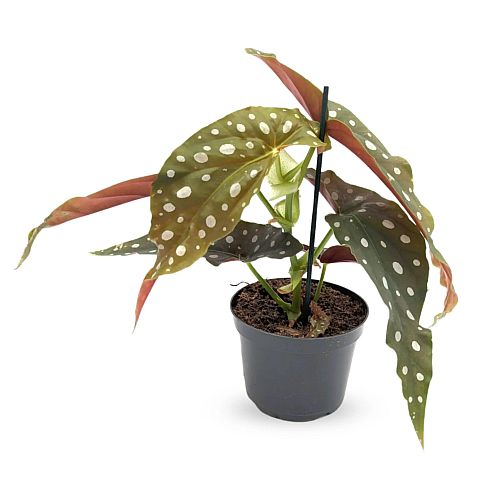Polka Dot Begonia (Begonia maculata)
Last
updated: August 3,
2025
Care
Sheet List
The
Polka
Dot Begonia is a stunning and popular houseplant celebrated for its
dramatic
foliage: deep green leaves adorned with striking silver or white polka
dots on
top, and a rich red or burgundy underside. It typically grows with an
upright,
cane-like stem, earning it the "cane begonia" classification.
Lighting
Polka
Dot
Begonias prefer bright, indirect light.
- Ideal: A spot near an
east-facing window is excellent, or a few feet away from a south or
west-facing window where it receives plenty of bright light without
direct sun.
- Benefits: Good light will
ensure vibrant leaf coloration and encourage robust growth.
- Avoid: Direct
sunlight can scorch their delicate leaves. Too little light
can lead to leggy growth, smaller leaves, and less prominent polka dots.
Watering
Routine
Polka
Dot
Begonias like consistently moist soil but absolutely hate
soggy conditions,
which can quickly lead to root rot.
- Frequency: Water when the top
1-2 inches of soil feel dry to the touch. Do not let the soil
dry out completely, especially during the active growing season.
- Method: Water
thoroughly until water drains from the bottom of the pot. Discard any
excess water from the saucer immediately.
- Seasonality: Reduce watering
frequency in fall and winter when the plant's growth slows down.
Fertilizer
Requirements
During
its
active growing season, typically from spring through early
fall, your
Polka Dot Begonia will benefit from regular feeding.
- Type: Use a balanced
liquid houseplant fertilizer or one slightly higher in phosphorus to
encourage blooming (though they are primarily grown for foliage).
- Commercial Recommendation: Miracle-Gro
Indoor Plant Food (Liquid) or Schultz Liquid Plant
Food are easily available options. Dilute these commercial
concentrates to achieve approximately 50-100 ppm N in your
final solution. This is often equivalent to using them at "half
strength" or "full strength" of the package's recommended dose.
- DIY Fertilizer Suggestion: For optimal results, use
your homemade 3-1-2 liquid fertilizer concentrate (High
Nitrogen) for lush foliage, or the 1-2-1 liquid fertilizer
concentrate (High Phosphorus) to encourage blooming.
- For 3-1-2 concentrate (30,000 ppm N): Apply at a
"Light to Moderate Feeding" rate, using 1.67 ml to 3.33 ml per 1
liter of water (resulting in ~50-100 ppm N). See recipe details.
- For 1-2-1 concentrate (10,000 ppm N): Apply at a
"Moderate Feeding" rate, using 10 ml per 1 liter of water
(resulting in ~100 ppm N). See recipe
details.
- Avoid: Do not
fertilize in late fall and winter when the plant is dormant or growing
slowly.
Misting
Requirements
Polka
Dot
Begonias are tropical plants and love high humidity.
This is a key
factor for their health and preventing crispy leaf edges.
- Recommended: Aim for
humidity levels of 50% or higher.
- Methods:
- Misting: Mist the
foliage regularly, daily or every other day, with room-temperature
water.
- Pebble Tray: Place the pot
on a pebble tray filled with water (making sure the pot is not sitting
directly in the water).
- Humidifier: Using a room
humidifier nearby is also very effective.
- Grouping: Grouping with
other plants can help create a microclimate with higher humidity.
Pot Size
and Soil Type
- Pot Size: When repotting
(best done in spring), choose a pot that is 1-2 inches larger
in diameter than its current one. Polka Dot Begonias don't
mind being somewhat root-bound, and this can help prevent overwatering.
Ensure the pot has excellent drainage holes.
- Soil Type: Use a well-draining,
airy potting mix that retains some moisture. A standard
houseplant potting mix can be amended to be ideal.
- A good recipe
would be:
- 2 parts
all-purpose potting mix
- 1 part perlite
- 1 part orchid
bark or coarse coco coir
- This mix
provides the necessary drainage and aeration while still holding enough
moisture for their needs.
Pruning
and Maintenance
- Pruning: To encourage a
bushier, more compact plant and to control its height, prune back leggy
stems. You can cut stems just above a node or side shoot. Regular
pinching of new growth can also promote branching.
- Propagation: Polka Dot
Begonias are relatively easy to propagate from stem cuttings. Take a
cutting with a few nodes and place it in water or moist potting mix.
- Leaf Drop: Some leaf drop,
especially older lower leaves, is normal. Excessive leaf drop can
indicate issues with watering (too much or too little), humidity, or
temperature fluctuations.


